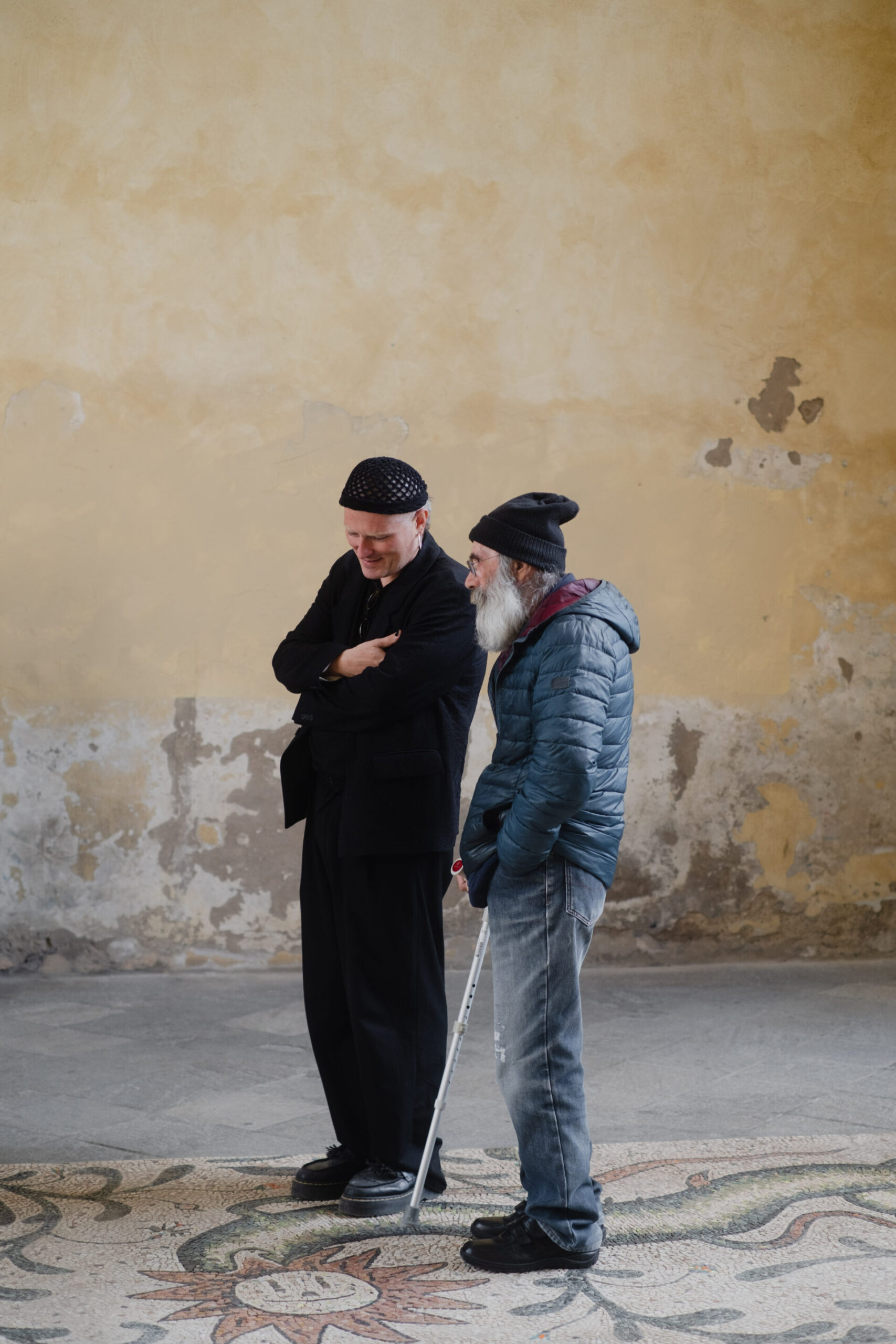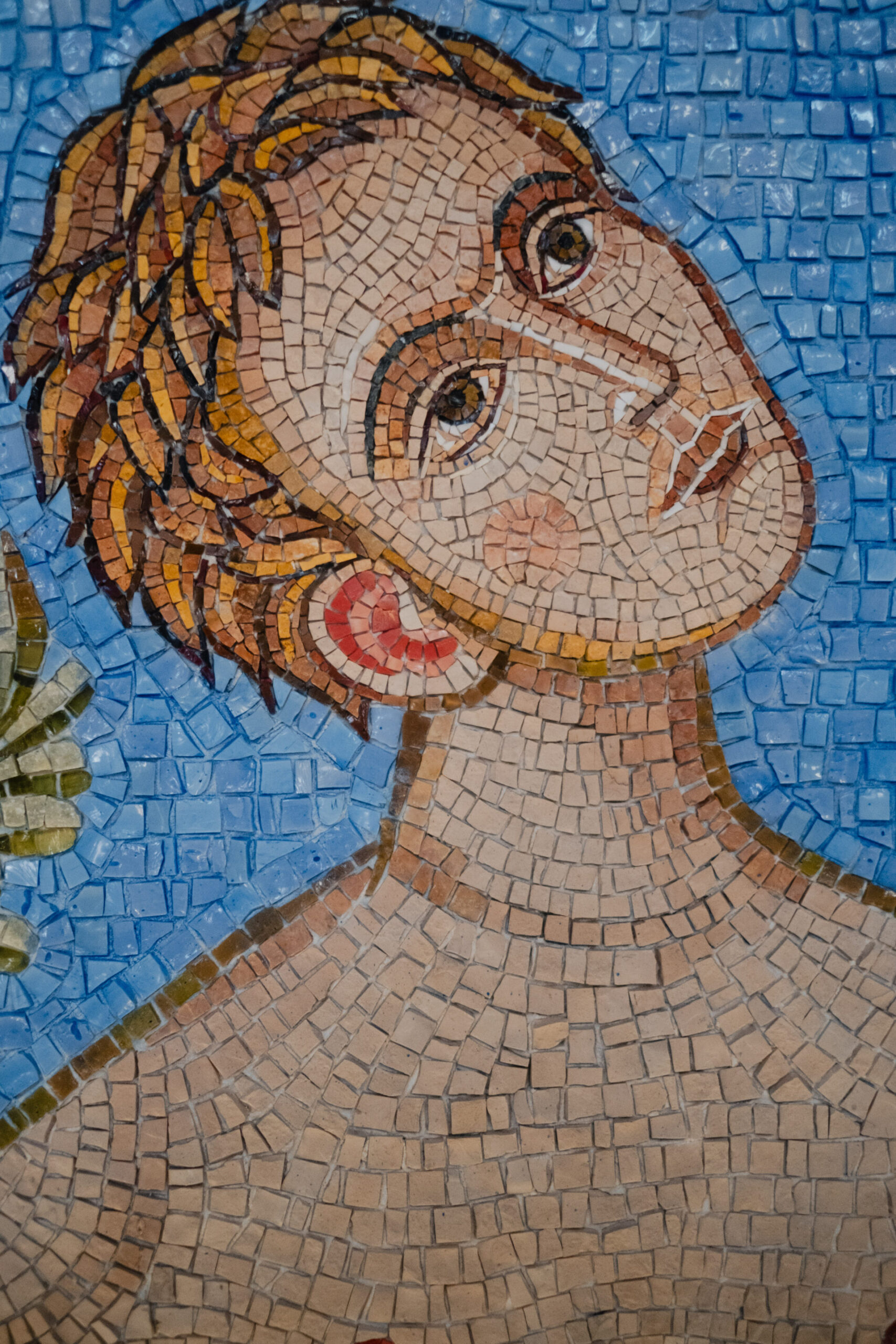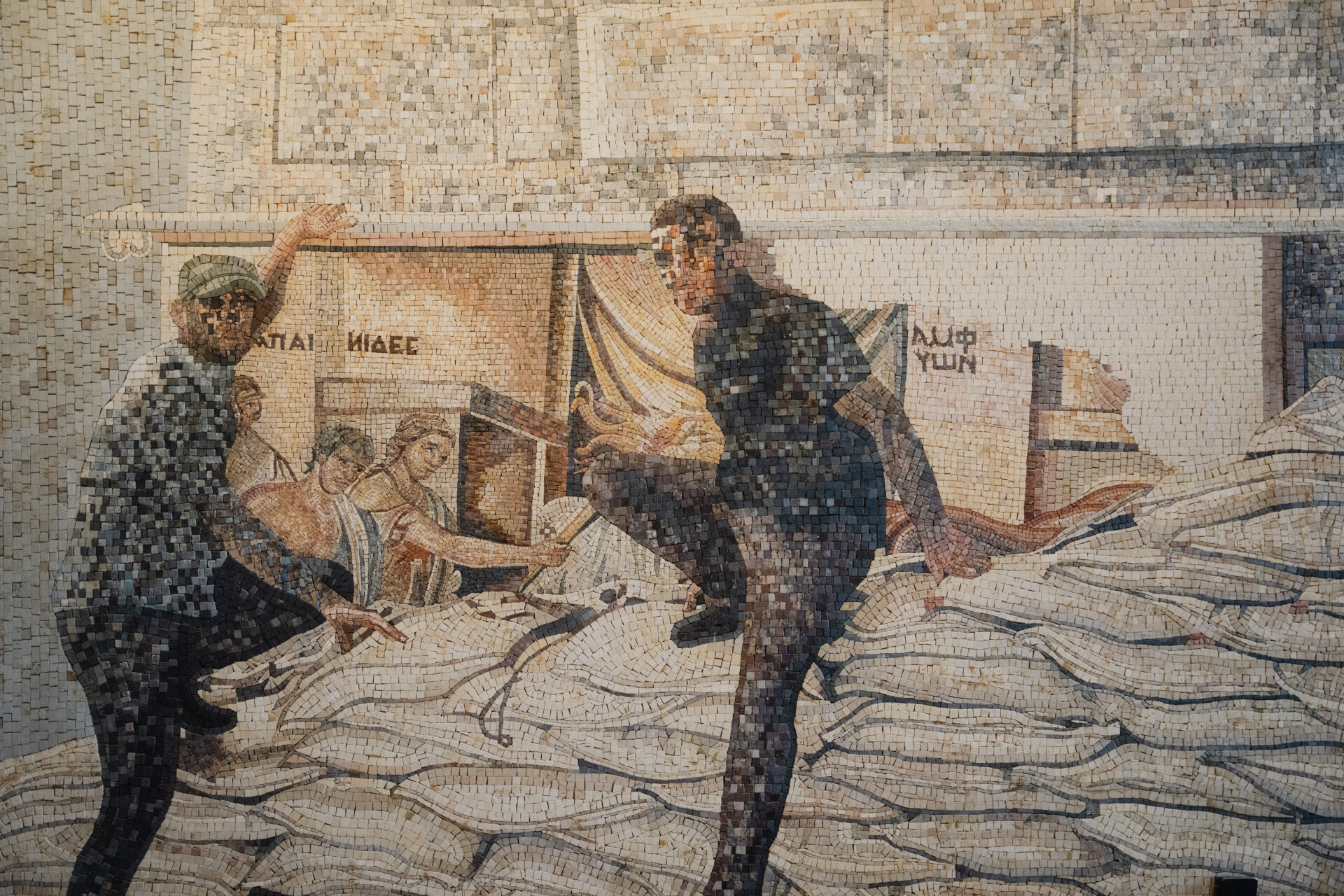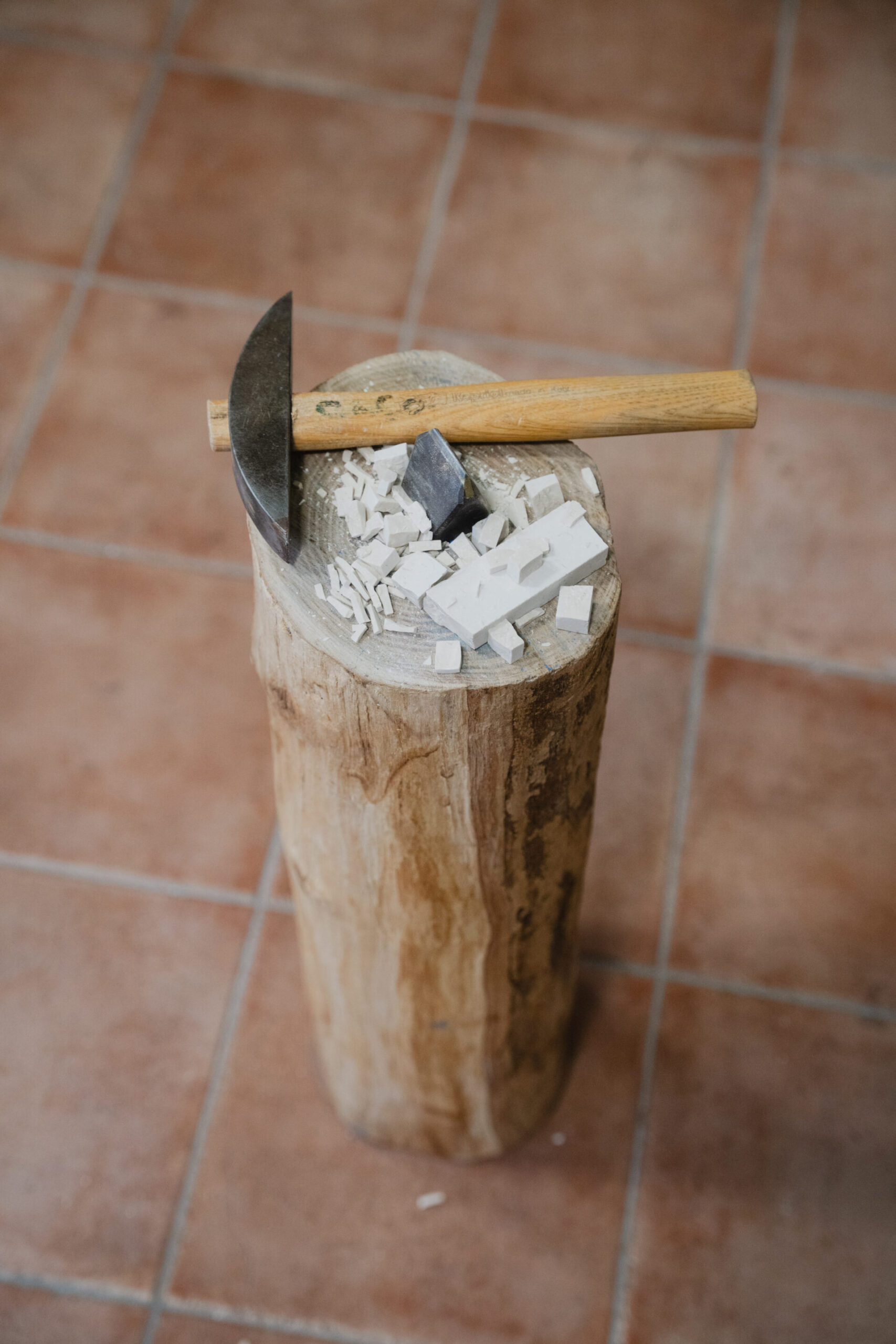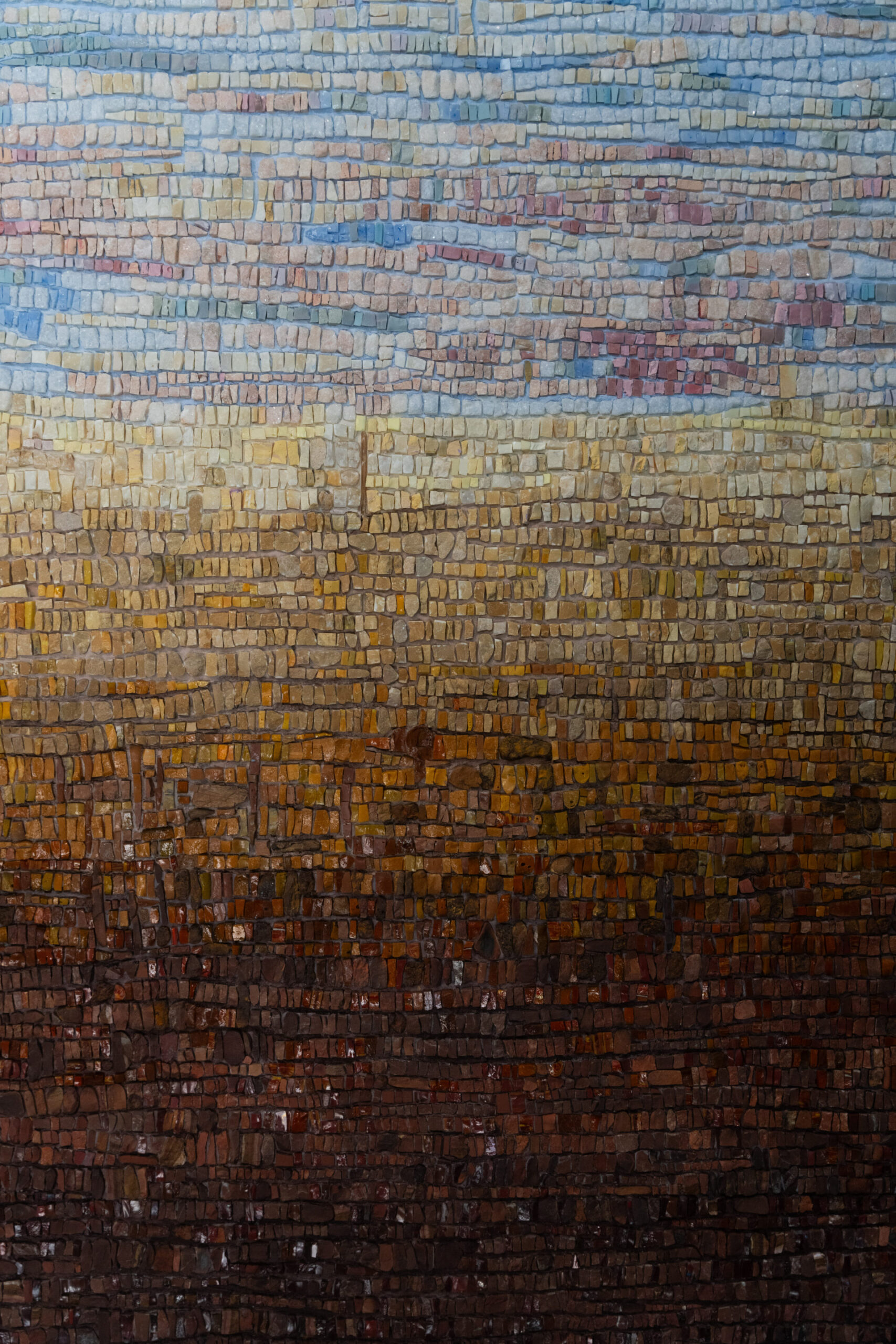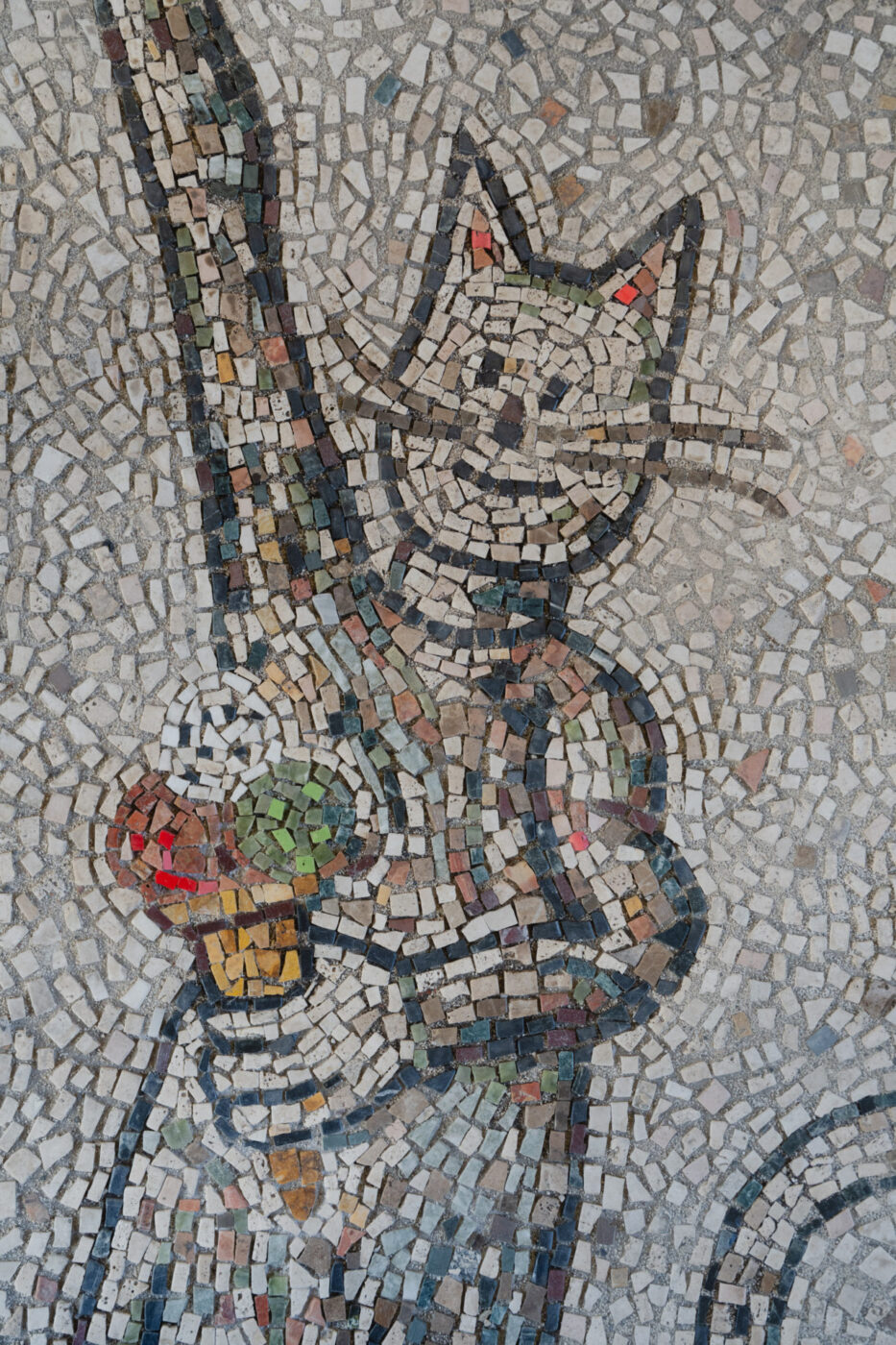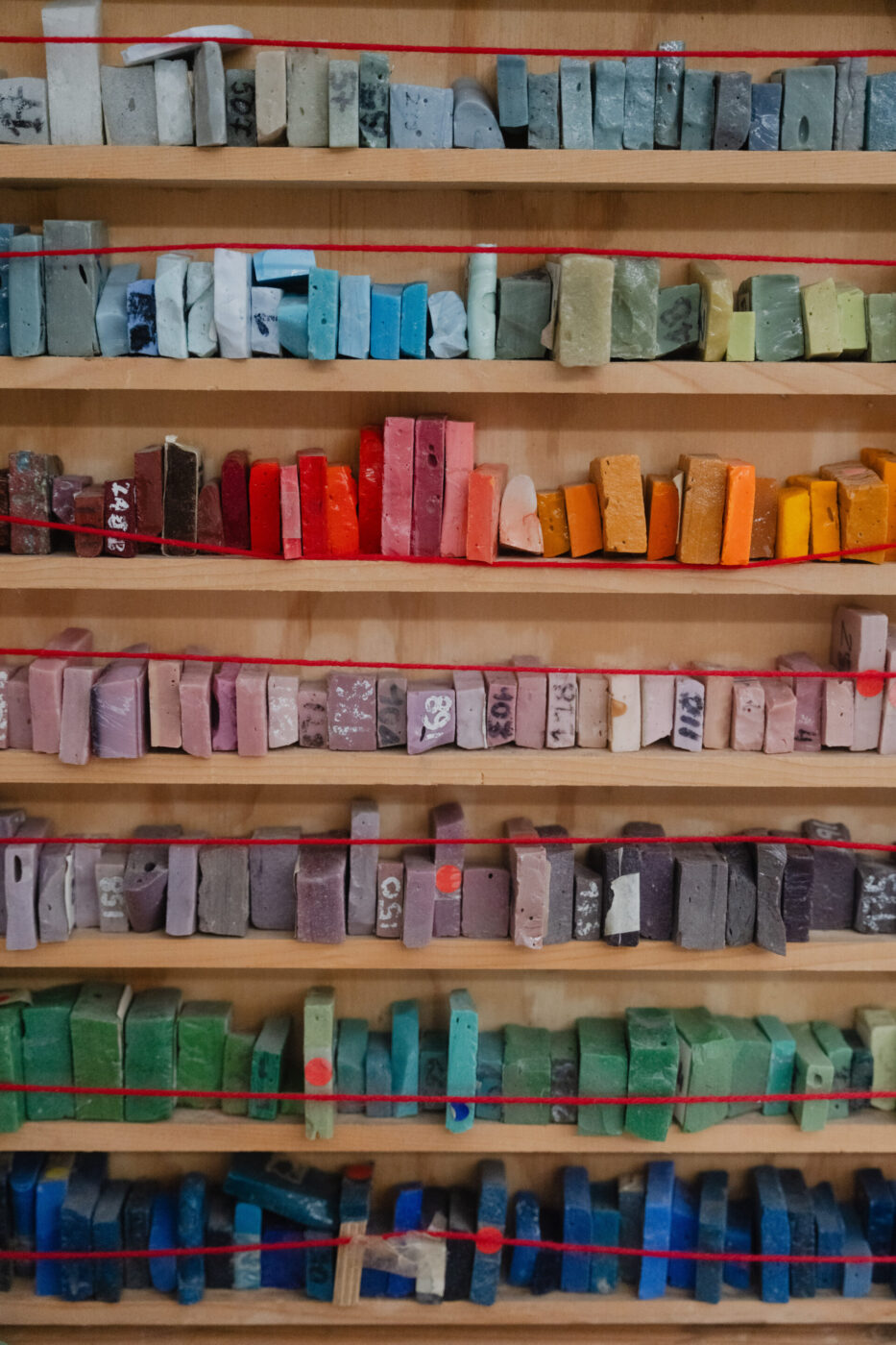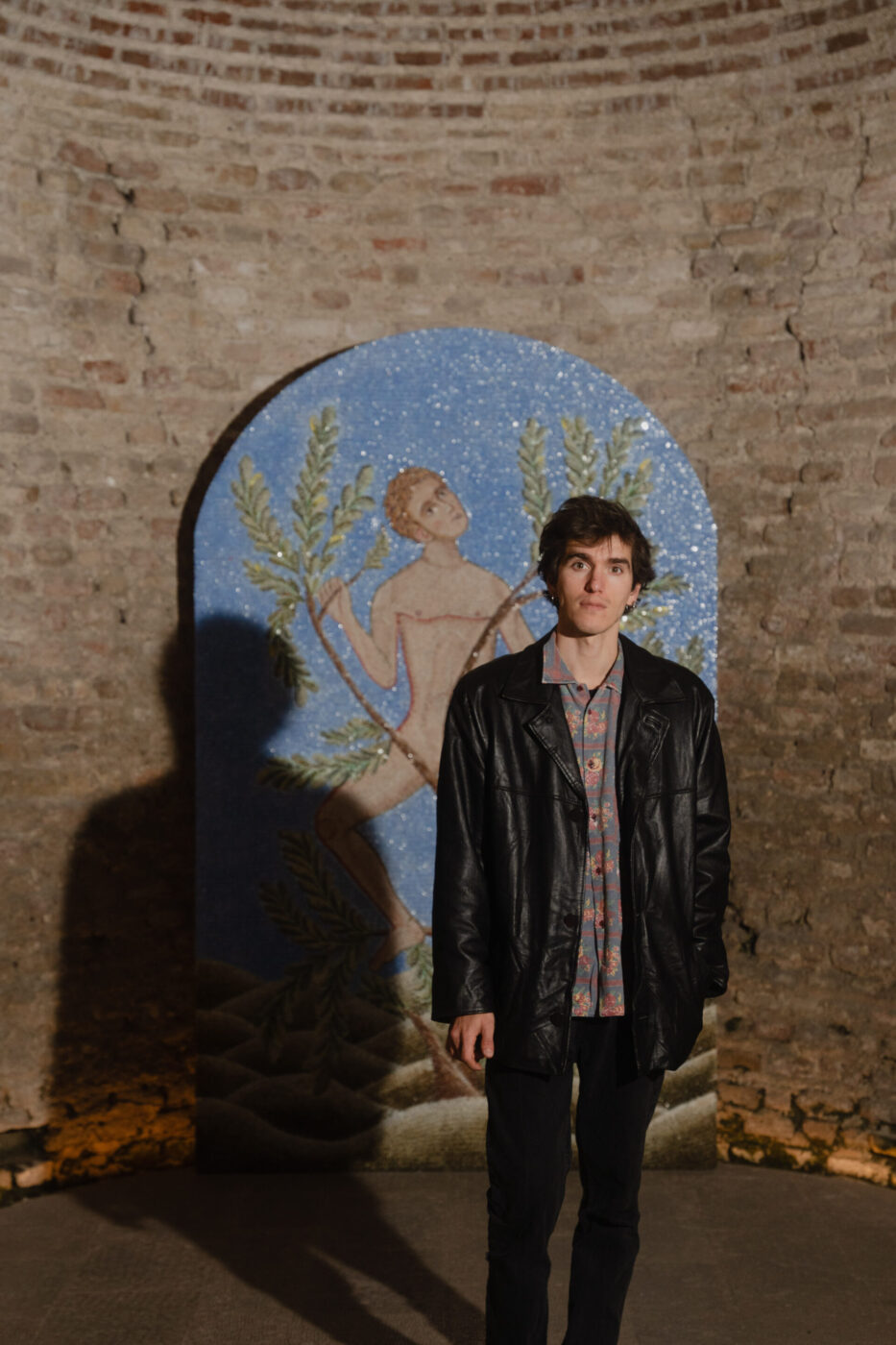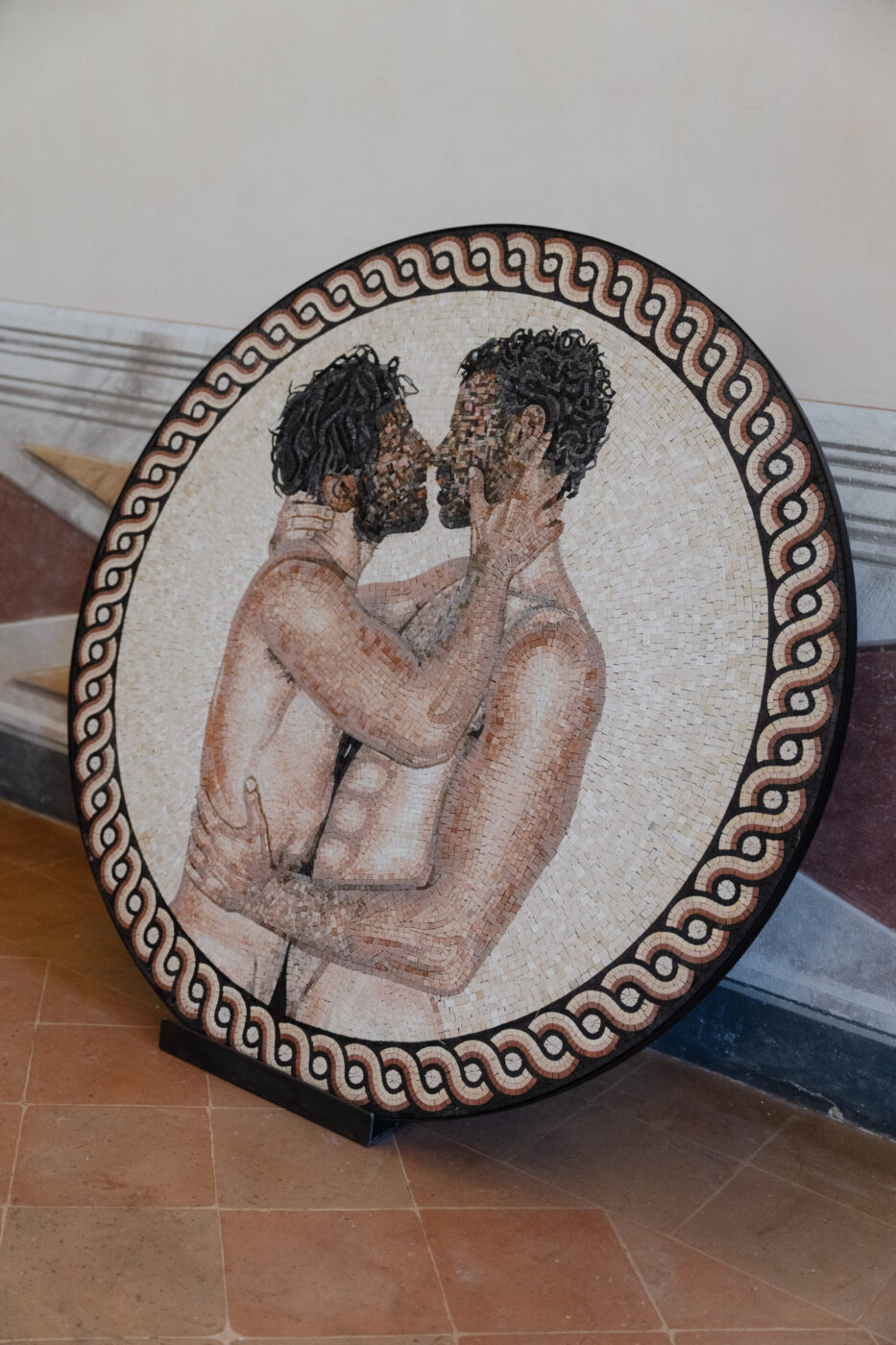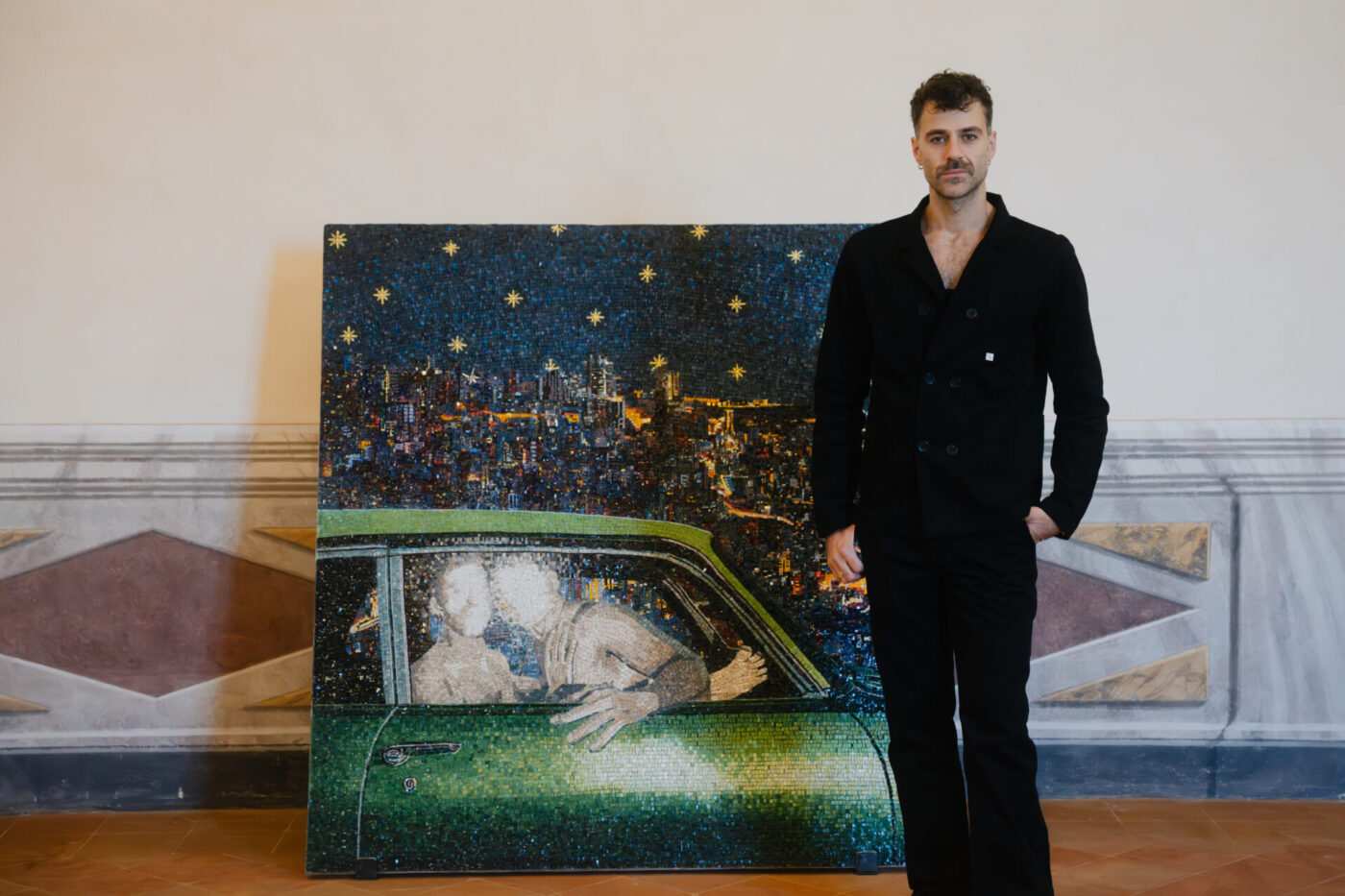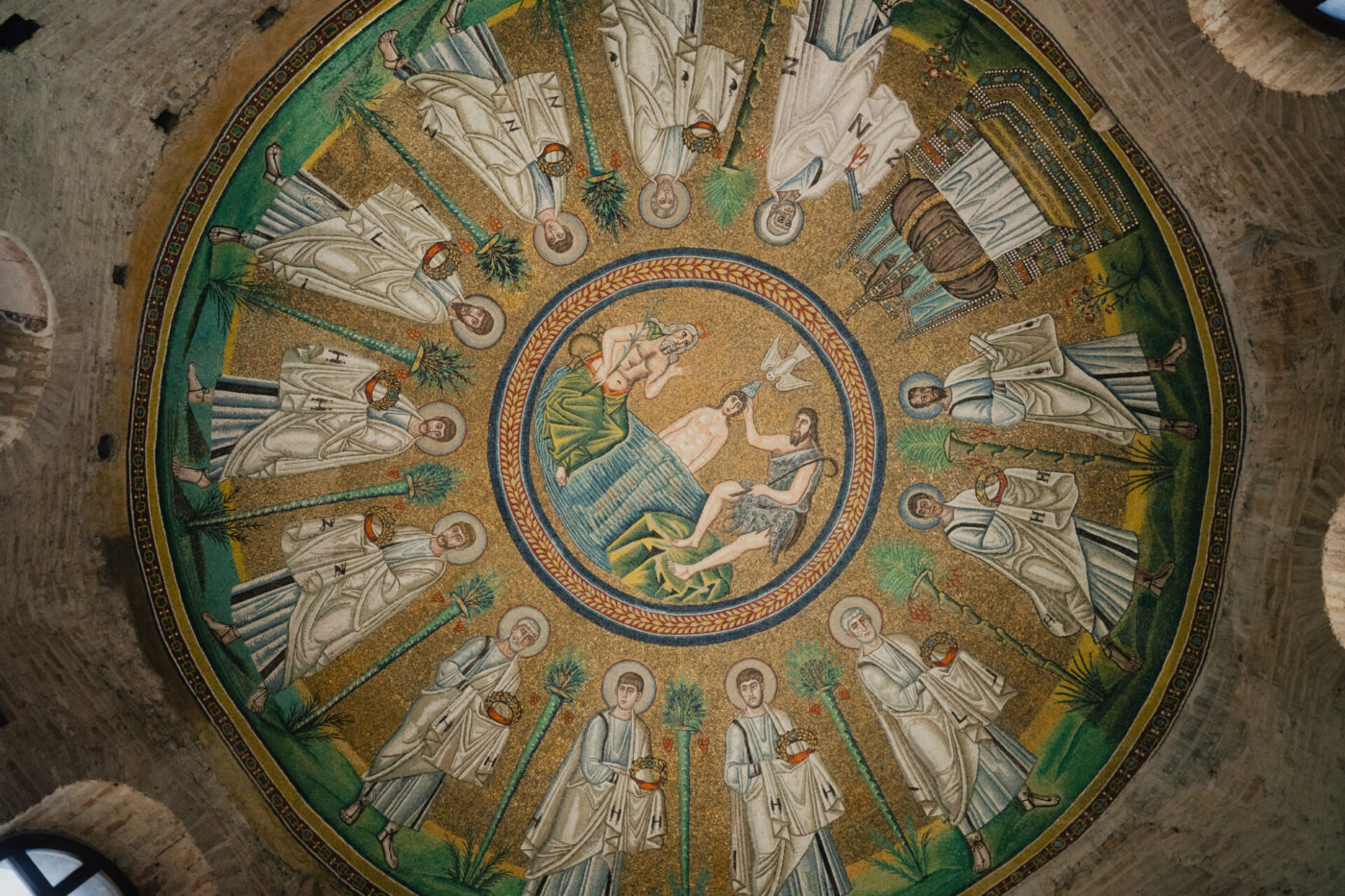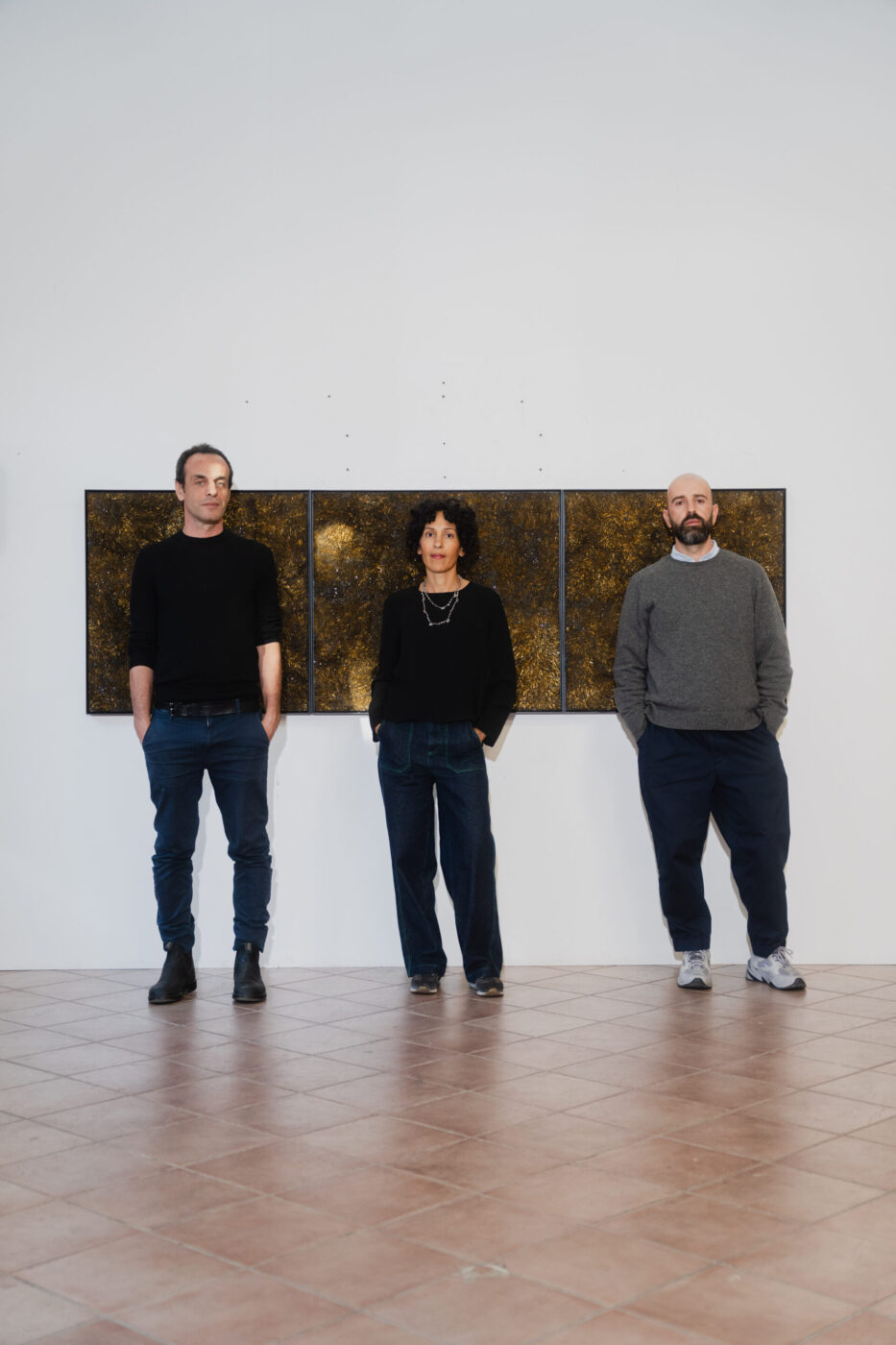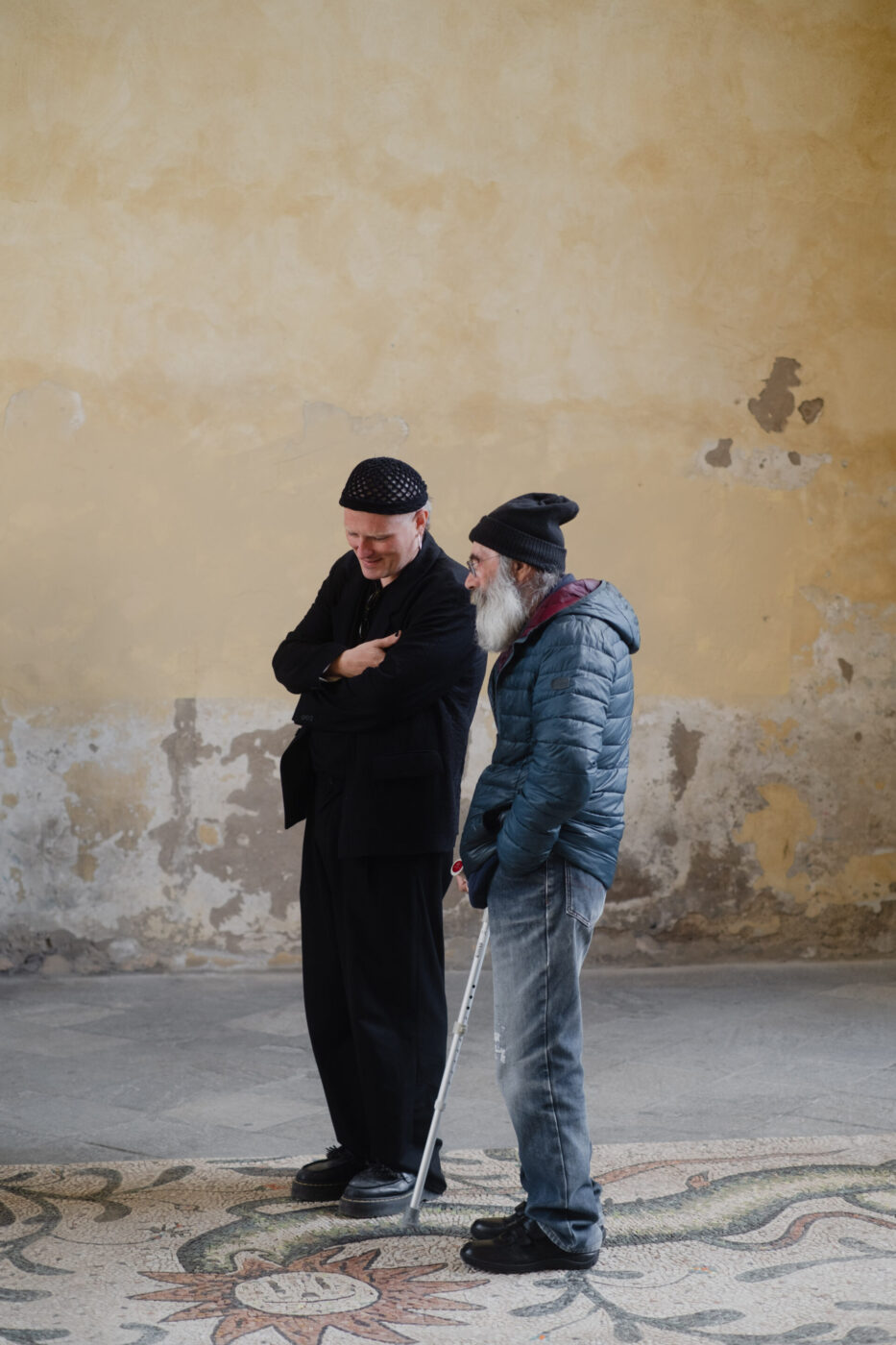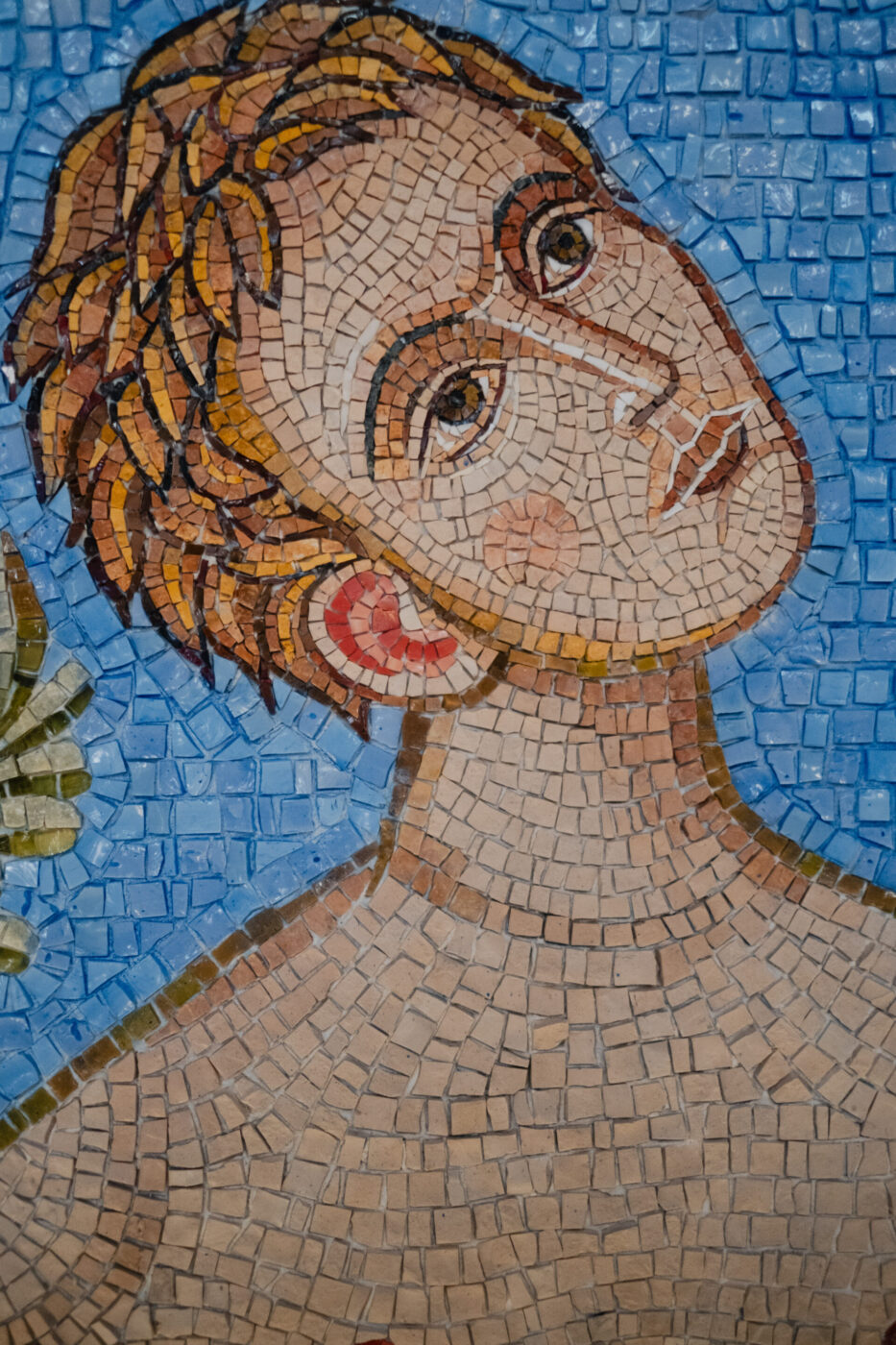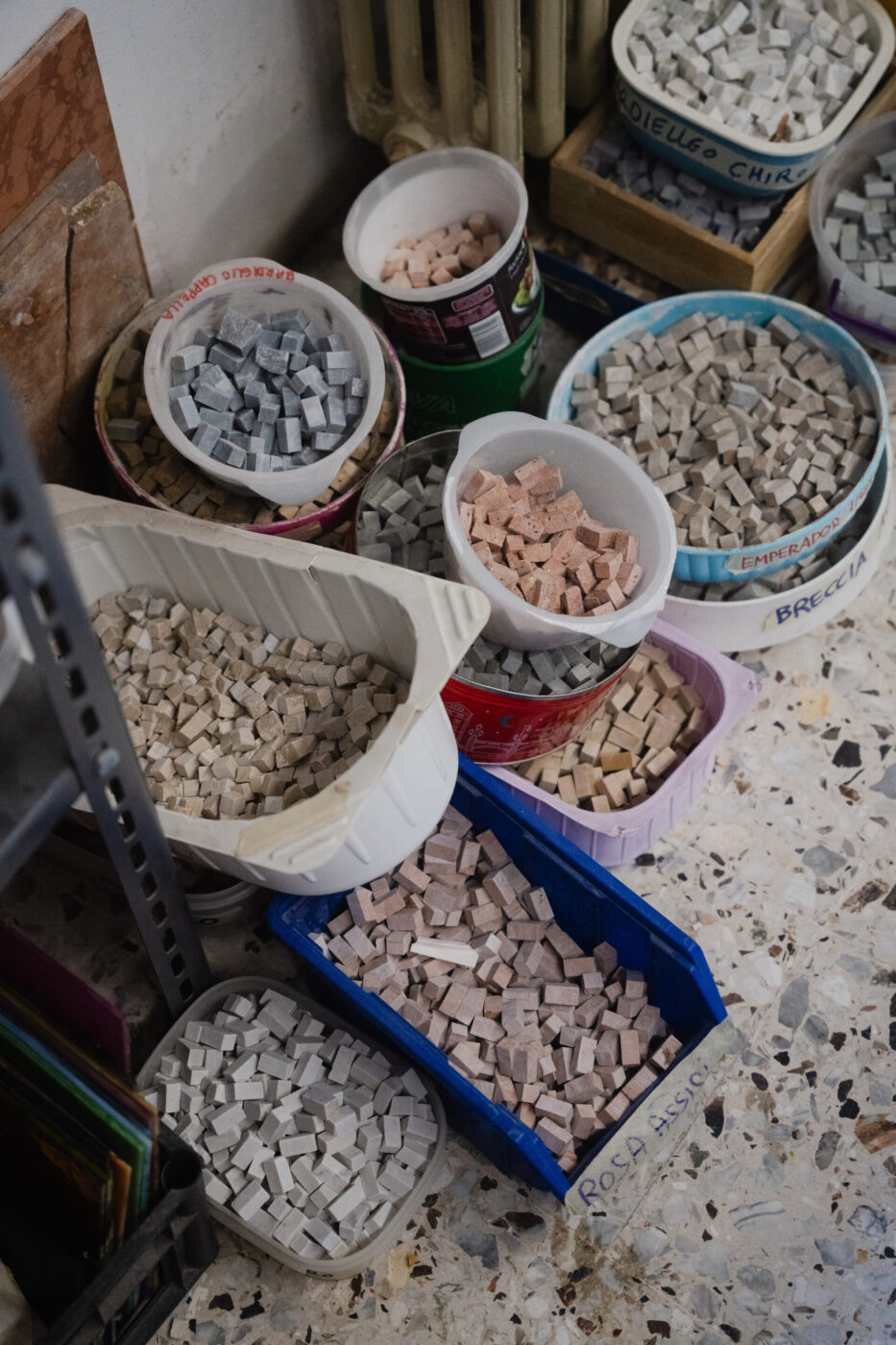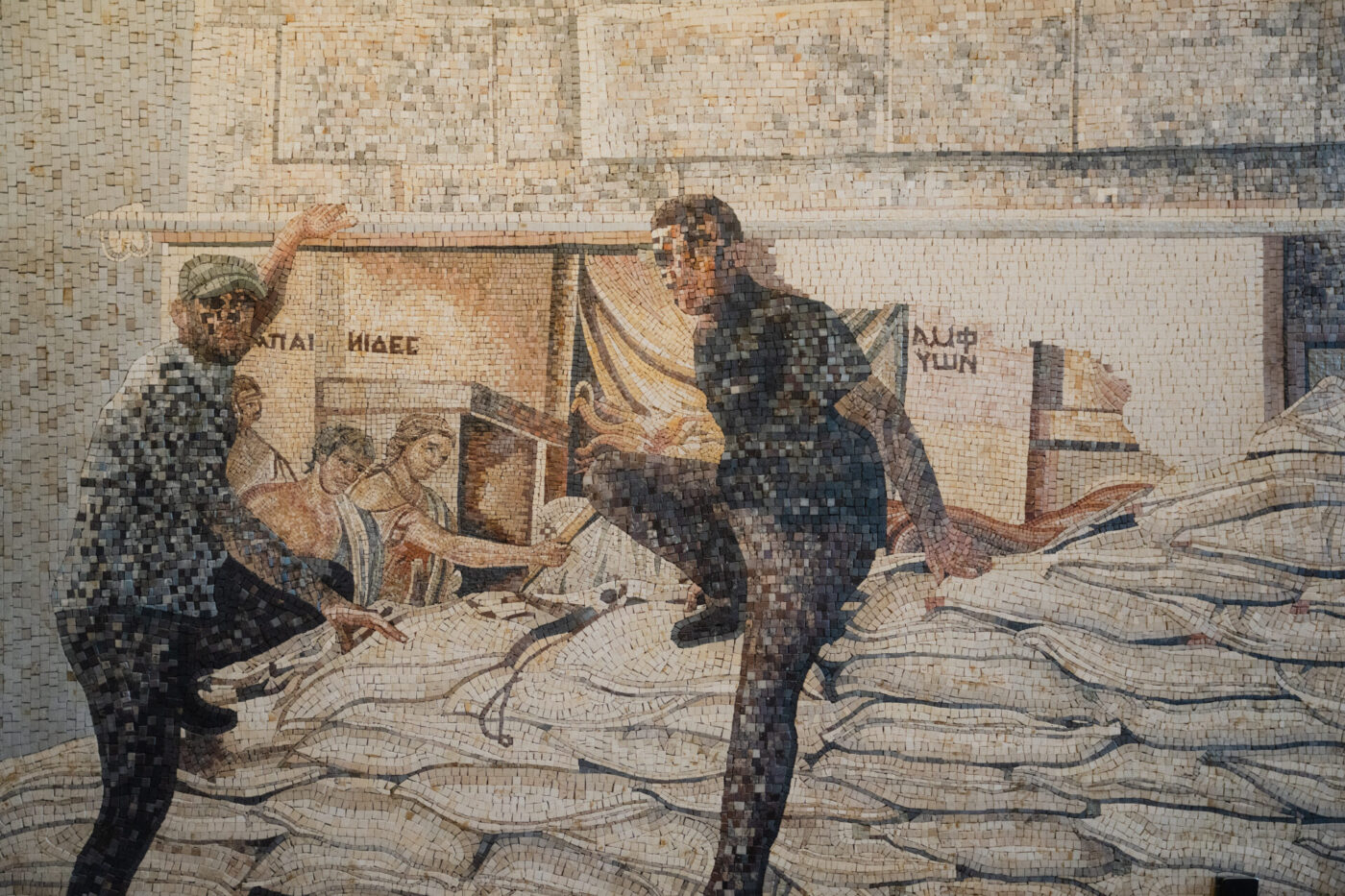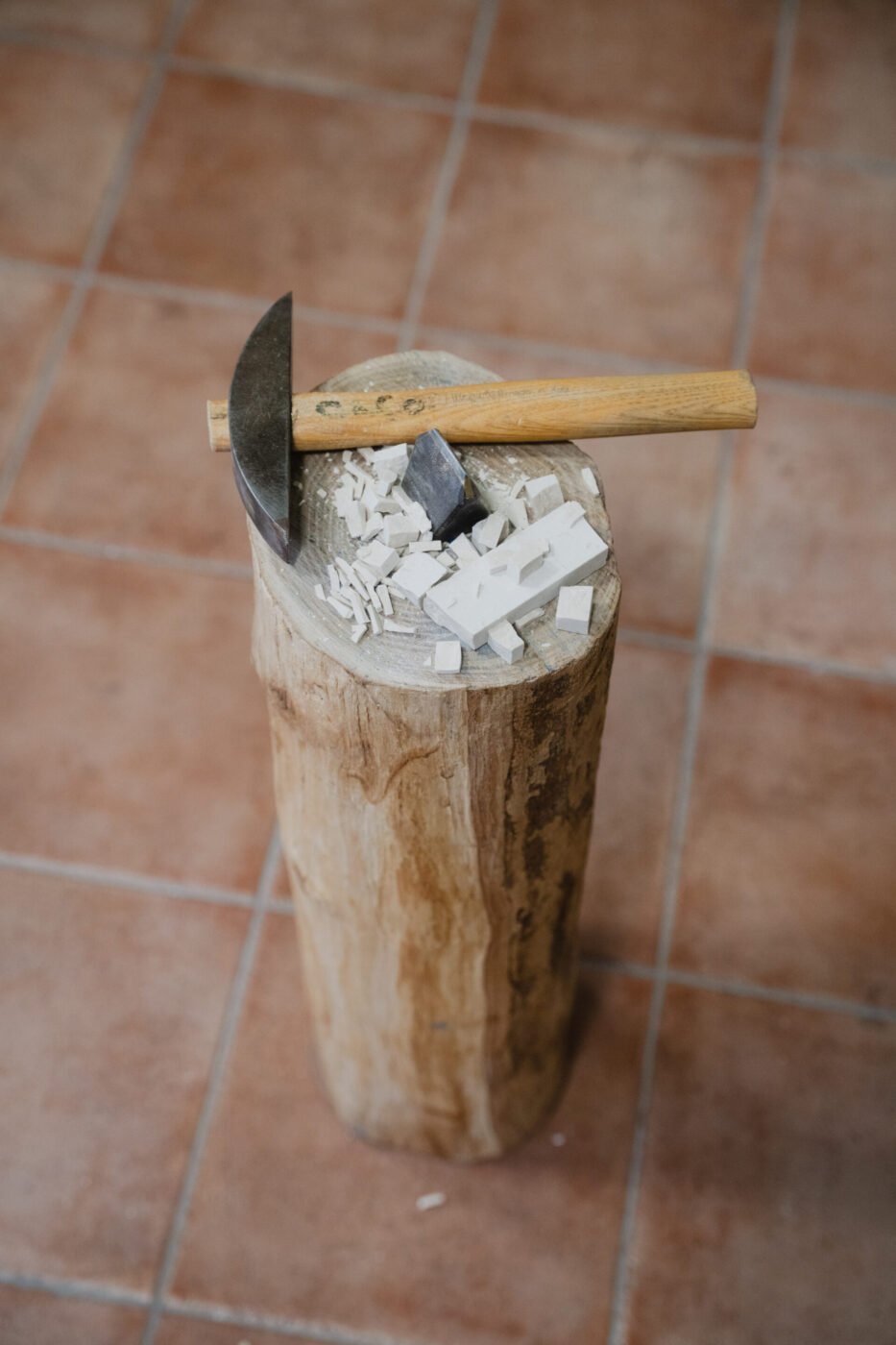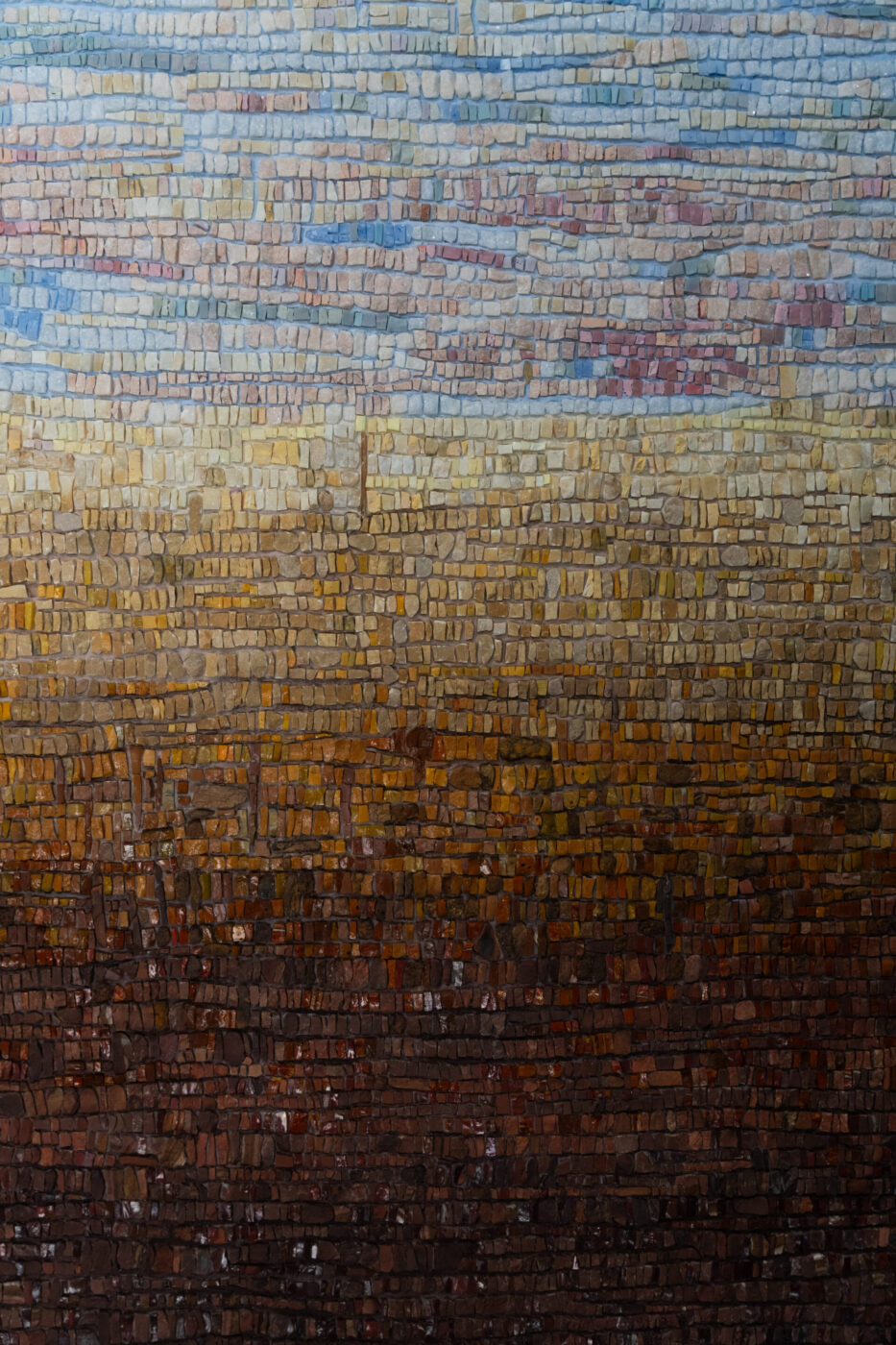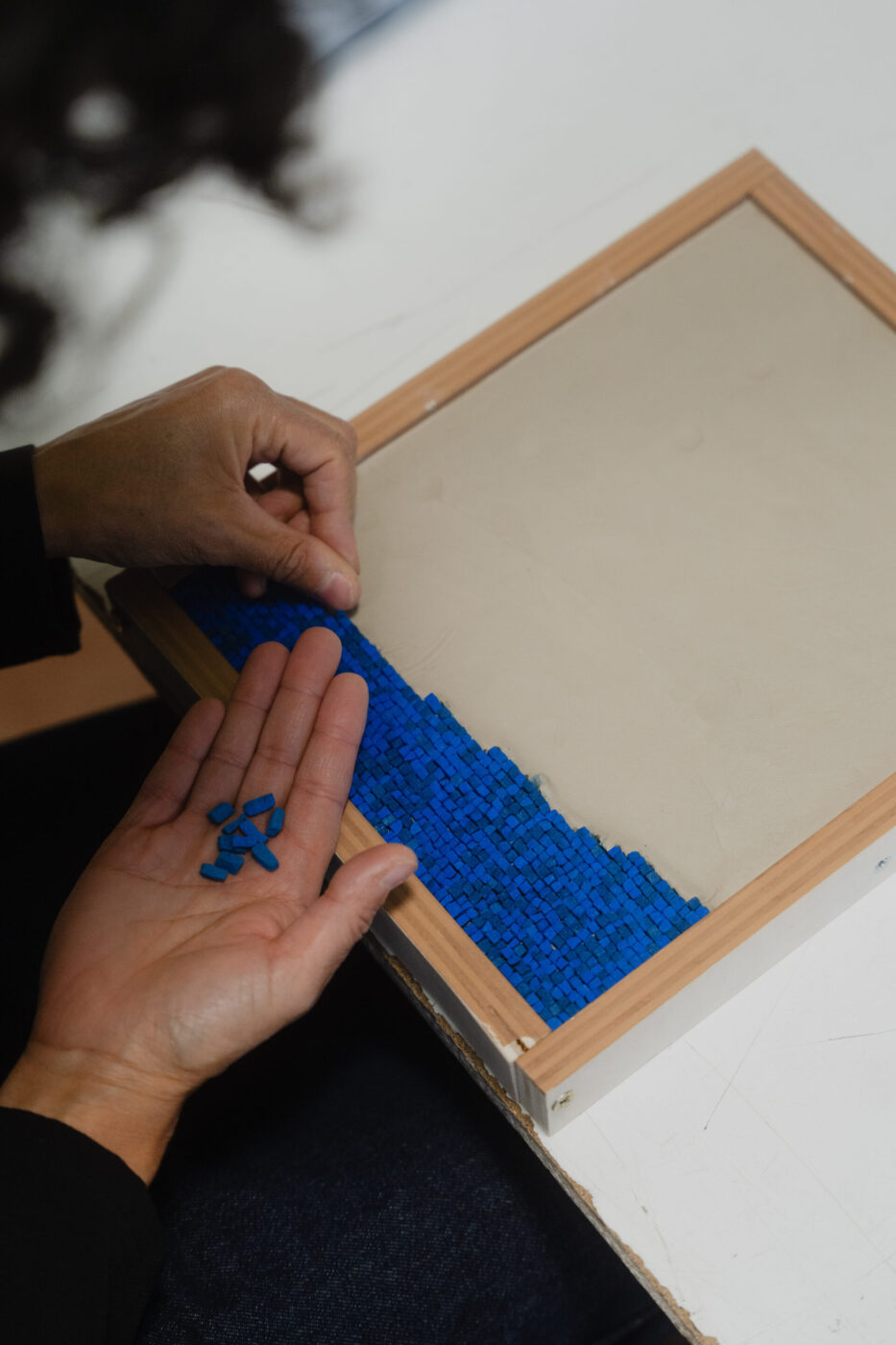“It’s a bit of a punk choice to make a pavimento mosaic like this in Ravenna,” Nicola Montalbini admits. The artist is nervous. He stands with a group of press, collaborators, and city officials who have gathered at Porta Adriana to witness the unveiling of his new floor mosaic, Il Pavimento, which has been in the making for more than two years.
It’s a big day for Montalbini, and this is a big deal. By “punk choice,” he probably refers to the fact that here in his home city of Ravenna—a city with a mosaics legacy dating back to the 5th century AD—his 10-by-four-meter mosaic (which covers the entire floor of what was historically the main entrance to the city) is a “living” installation that will likely redefine public perception of mosaics, both now and for generations to come.
The white sheet covering the floor is slowly pulled back. Gasps, whispers, photos . . .
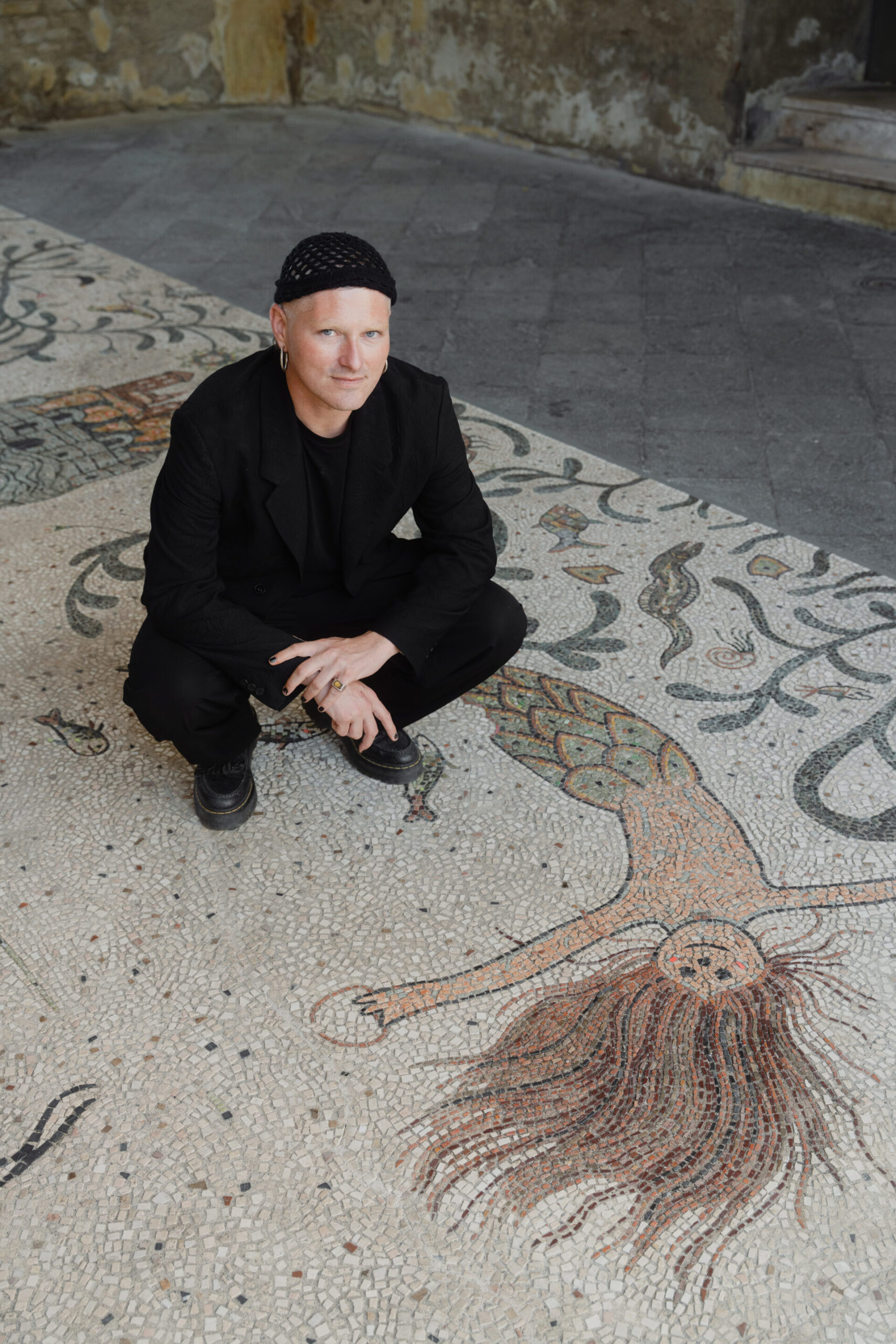
Nicola Montalbini christening "Il Pavimento"
At first glance, the scene has all the aesthetic and technical virtues of an ancient Roman mosaic that might have once existed in Pompeii, Ostia Antica, or Aquileia. But on closer view, Montalbini’s pavimento reveals its surreal, fantastical, and even autobiographical subject matter—a scene that merges past, present, and future with an endearing dash of humor. Among the symbolic characters in the work are a tiger, a bear, a mermaid, an ostrich, and a cat-like man with an ice cream in his hand, who, we discover, represents the artist’s grandfather.
“What are you waiting for?” Montalbini asks onlookers; nobody dares be the first to step on it. “Walk on it, that’s the whole point!”
Created according to the ancient Roman mosaic technique, which the artist has studied tirelessly since he was eight years old, Il Pavimento is now a permanent fixture in Ravenna, a gift to the city unveiled as part of the IX Biennale di Mosaico Contemporaneo. The ancient Romans would no doubt be on their feet applauding Montalbini and Ravenna’s Gruppo Mosaicisti and Academy of Fine Arts, who collaborated with him to create the work. But the contemporary populus—every person and their dog, in fact—are already going about their business on this mosaic as though it has been there for years.

Montalbini's grandfather reimagined in mosaic form
But let’s backtrack a few centuries, back to when mosaics depicted saints and emperors, not cat-like men holding ice creams. Ravenna, this quaint city in Emilia-Romagna just off the Adriatic, was the seat of the Roman Empire in the 5th century and the helm of Byzantine Italy until the 8th. Mosaics have been its crowning glory for thousands of years. Gaze up at the tiled ceilings of the Basilica di San Vitale or the Mausoleo di Galla Placidia and you’ll see exactly why. The “supreme artistry” (says UNESCO) of these mosaics feature gold, glass, and precious stone tesserae set with astonishing precision, merging Roman naturalism and Byzantine symbolism in scenes that feel eternally luminous. Known as the Città di Mosaico, Ravenna draws people from far and wide to witness some of Europe’s most extraordinary works, which feature across eight main landmarks forming the city’s UNESCO World Heritage-listed Early Christian Monuments of Ravenna.
From saints and biblical scenes to imperial figures and symbolic imagery, Ravenna’s mosaic feats are among the best-preserved examples of Christian and Byzantine mosaics in the world. Aesthetics aside, they represent the art form’s historical function as visual theological sermons and as displays of imperial wealth and power—a sky full of gold and lapis lazuli is no lucky accident—as well as its enduring religious presence and its links to classical traditions and intellectual sophistication. With all this in mind, it’s reasonable to perceive mosaics as an art form bound to the past—ceremonial, static, and largely decorative. Right?

Whatever you thought about mosaics, the Biennale di Mosaico Contemporaneo asks you to think again. Yes, that even means embracing the fact that in today’s terms, a mosaic could be made from Tic Tacs (as seen in young artist Irene Giornelli’s work Fenicottero). Art critic, scholar, and professor Daniele Torcellini is the artistic director of this year’s edition of the internationally acclaimed event, which runs until January 2026. Unfolding across key locations in Ravenna, the biennale celebrates mosaic as a medium for contemporary artistic expression, experimentation, and cultural exchange. From Ravenna’s MAR Museum (which stages the first-ever exhibition dedicated to painter Marc Chagall’s foray into mosaics) to the Battistero degli Ariani, Palazzo Rasponi delle Teste and Biblioteca Classense, the biennale map takes you to over 40 sites around the city. Emerging and established mosaic artists and studios present new works and installations using techniques and materials that recast traditional conventions in a new dimension. Additionally, an international lineup of contemporary visual artists—Omar Mismar, Ismaele Nones, Shahzia Sikander, and Nicola Montalbini among them—have collaborated with Ravenna’s mosaic academies to have their paintings, sketches, and imagery reimagined into mosaics that engage with contemporary perspectives on popular culture, politics, sexuality, gender, and identity.
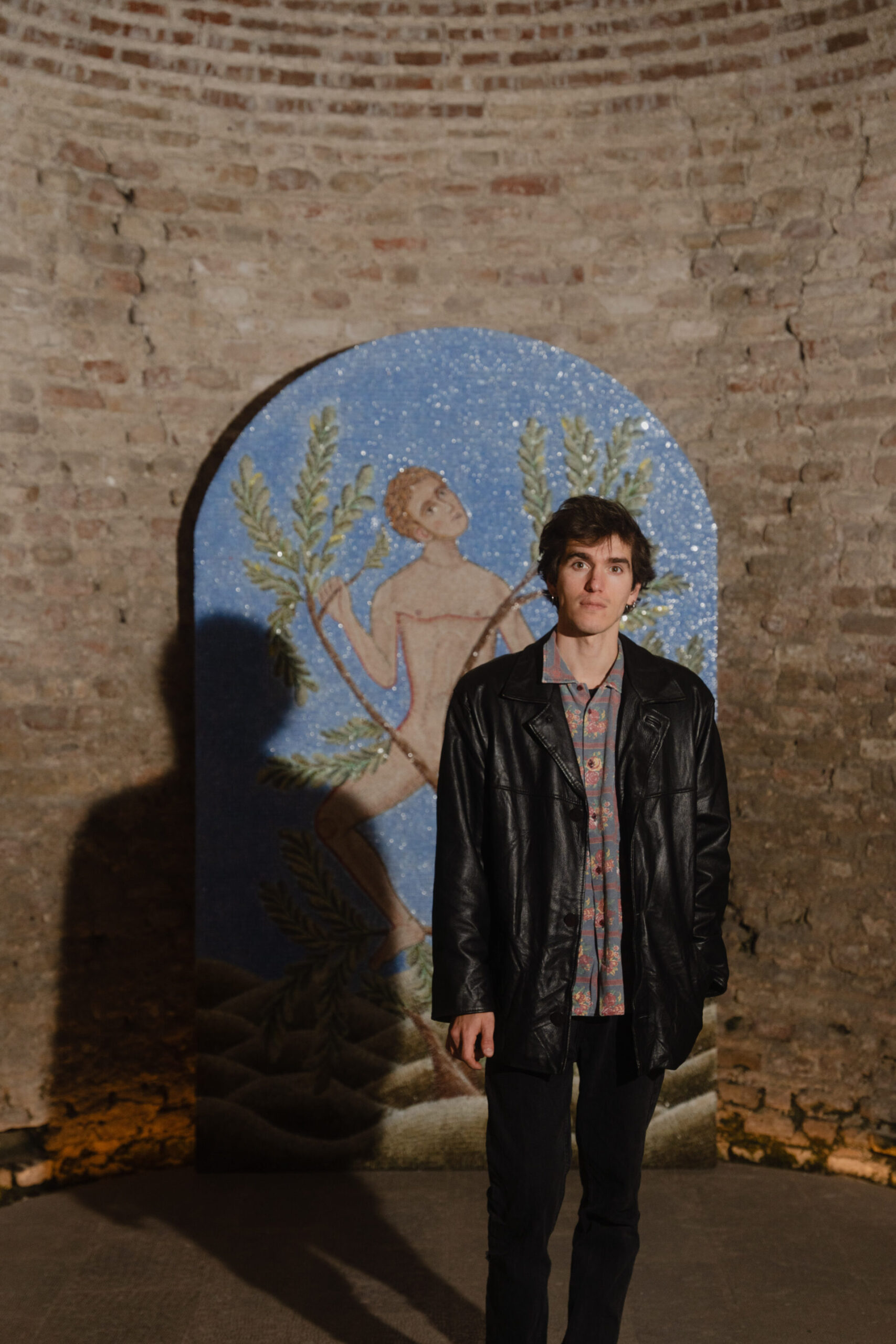
Ismaele Nones with his work "Verso l’Alto, verso la Terra: Sguardo al firmamento"
Two exhibits at Palazzo Rasponi delle Teste make the case that mosaics can be as expressive and reflective of contemporary society as any other artistic medium. This comes to life in Pakistani-American visual artist Shahzia Sikander’s show Breath, which presents two new works created in collaboration with students from Ravenna’s Academy of Fine Arts and Gruppo Mosaicisti. Exploring how the art form can reinterpret South Asia’s visual traditions (such as Mughal miniature painting, Persian and Indo-Persian manuscript illumination, and Islamic ornamental design) and spark dialogue between East and West, Sikander turns the mosaic into a dynamic form of self-expression.
“I thought mosaics were quite dead, or at least, I believed we had already reached a point of saturation with this visual language. Why make them? I asked myself initially,” Sikander shares.
“I wanted to give mosaics a sense of gesture and freedom, which is kind of counterintuitive to the square tiles. The square tile is rigid, inflexible. But I wanted to soften the rigidity of mosaics through gestures and meanings that transcend ornamentation—and also the hypermasculinity of historical mosaics. By exploring mosaic’s potential for self-expression you can give them a new energy, which I find exciting. It was kind of like painting with tiles.”
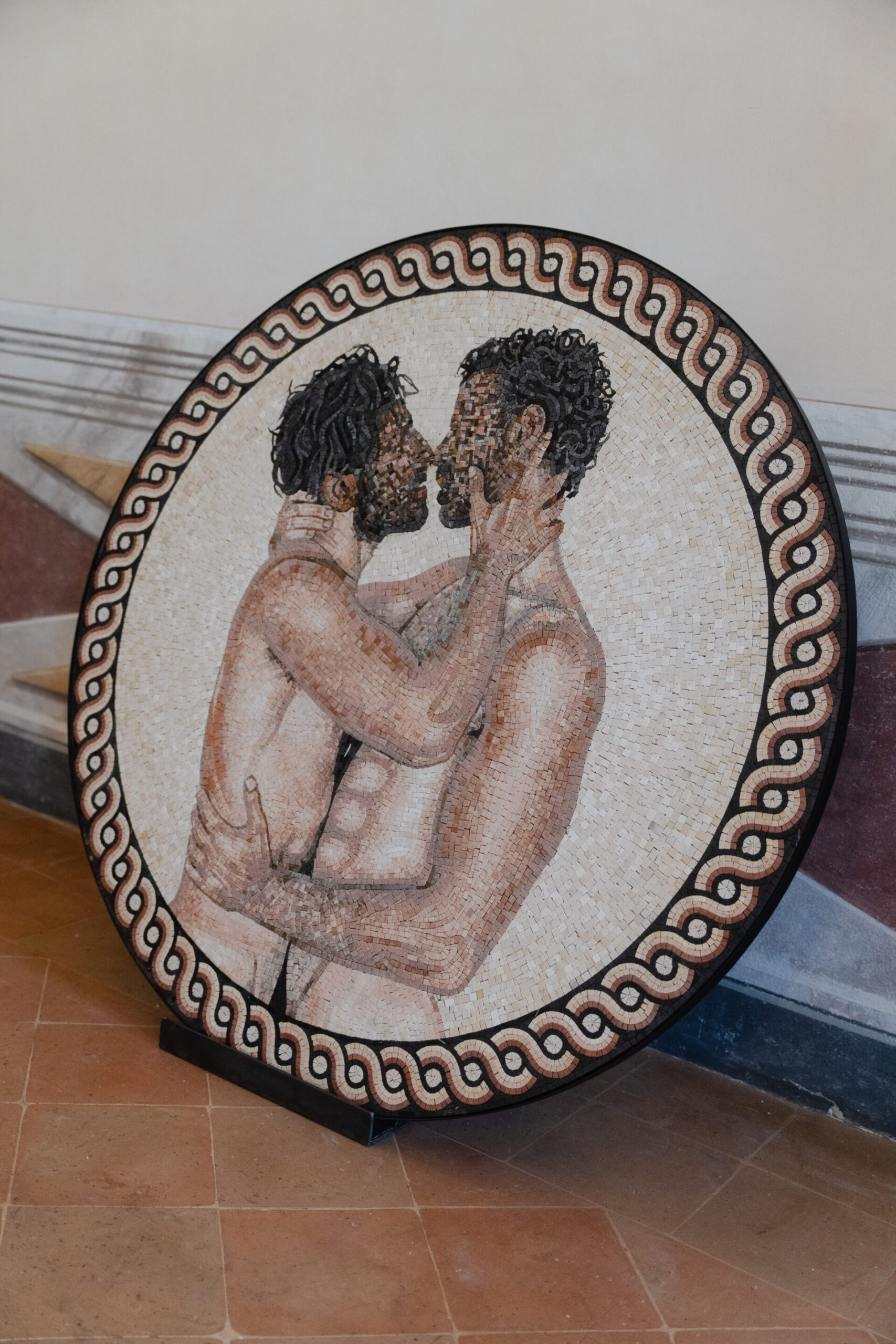
"Two Unidentified Lovers in a Mirror" by Omar Mismar
In the halls next door, Beirut-based interdisciplinary artist Omar Mismar’s exhibition Studies in Mosaics reimages mosaics in dialogue with photography, video, and media imagery. One of his works, Ahmad and Akram Protecting Hercules (2019–20), evokes a scene of two men safeguarding an ancient mosaic at the Ma’arrat al-Numan Museum (Idlib) during the 2015 bombings in Syria. Mismar’s other works explore themes of cultural heritage, queer identity, and interpersonal relationships through a lens he describes as a “documentary urge”—cast in ancient colors and techniques.
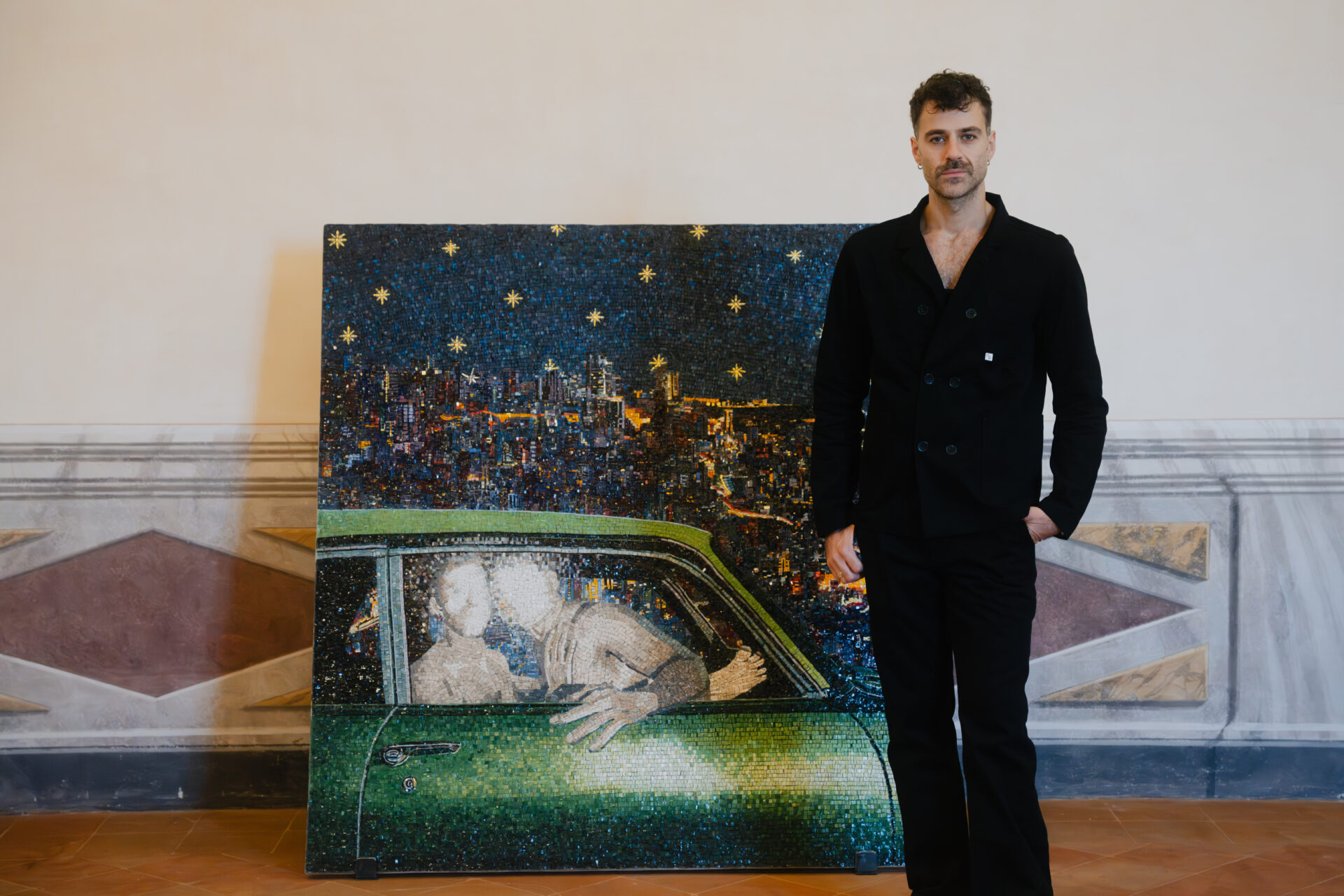
Omar Mismar with his piece "Two Unidentified Lovers in a Car"
The artist discusses his work created for this year’s biennale in collaboration with students from Ravenna’s Academy of Fine Arts: Unidentified Lovers in a Car (2025). With a lustrous palette of deep blues and greens reflecting Ravenna’s Christian and Byzantine mosaic heritage, the piece is a cinematic portal for contemporary reflections on sexuality, gender, and queer relationships.
“We often think of mosaics as a commemorative space for heroes and legends. However, I gravitate toward the everyday in my work—everyday scenes and everyday people. I’m particularly interested in how the everyday can be made strange, or how it can be transformed into a reality that we perceive in a different light,” Mismar says.
By this point, you’re probably more than ready to sit down for a piadina and wrap your head around everything you’ve seen so far. Certainly, mosaic does not just mean saints and square tiles—at least, not the contemporary kind. Meet Lecce-based visual artist Orodè Deoro, whose distinctly surreal and symbolic style features handcut, irregular-shaped tiles that give his compositions a sense of motion and energy. Deoro has two works on show inside Ravenna’s Museo Nazionale as part of this year’s biennale: Il Primo Tempio (The First Temple) and Futuro d’amore (Future of Love). And while some might have seen Ismaele Nones’s paintings of Byzantine icon-inspired figures at major museums like Triennale Milano, it’s something else entirely to visit the one reimagined as a site-specific mosaic installation inside Ravenna’s Battistero degli Ariani, created in collaboration with Ravenna’s Gruppo Mosaicisti.
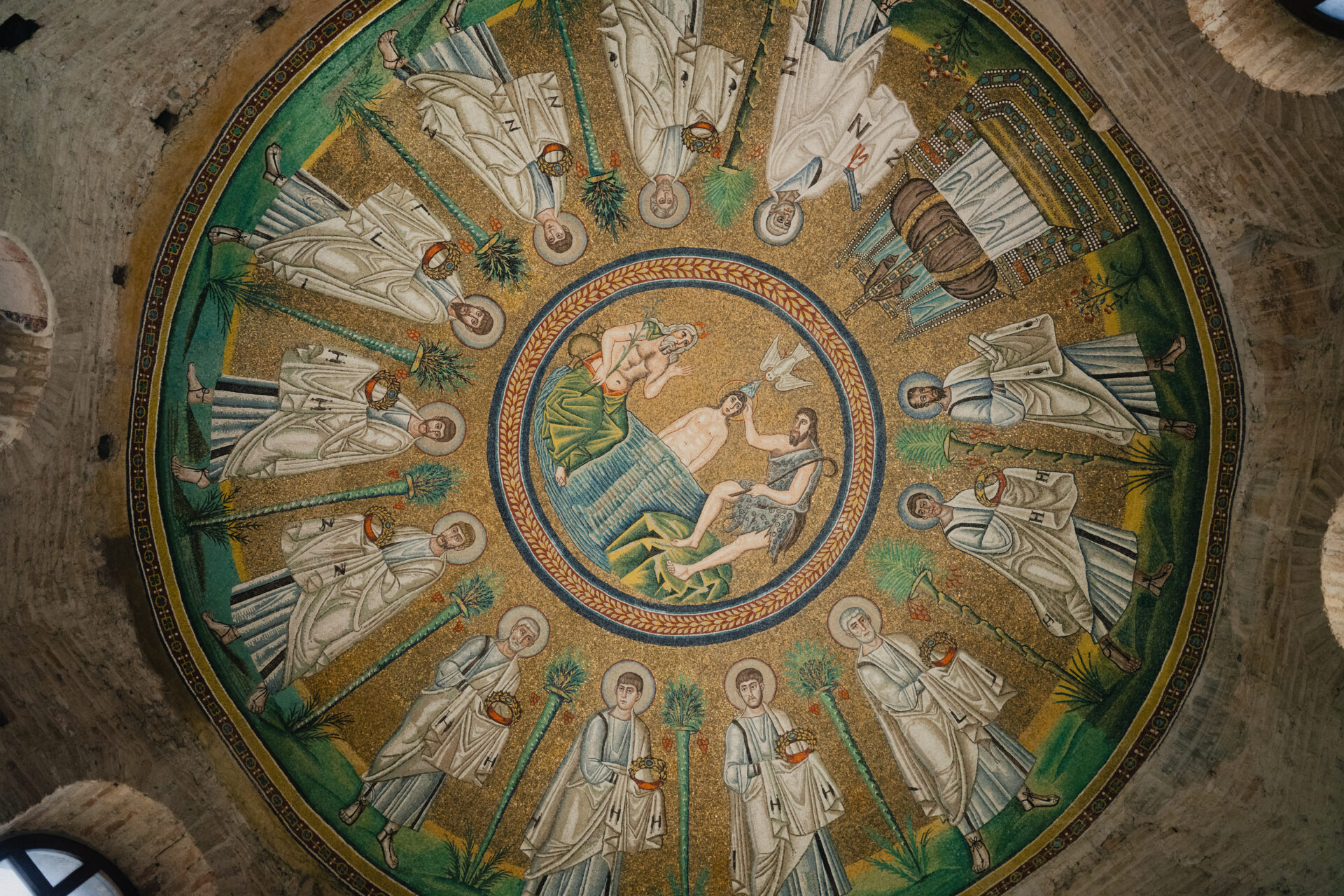
Inside the Battistero degli Ariani, UNESCO heritage site
Mosaics in motion? While this might sound like something of a paradox, Ravenna-based artistic trio CaCO3 is representing a new frontier of mosaic experimentation. Instead of using the traditional mosaic tile, Âniko Ferreira da Silva, Giuseppe Donnaloia, and Pavlos Mavromatidis explore compositions of glass, limestone, bricks, gold leaf, and marble on differently colored mortar backgrounds—creating light-diffusing compositions that carry their own sense of movement and rhythm.
“We are exploring the interactions of different material surfaces with light. Traditionally, if you wanted to achieve light and shade in a mosaic, you needed to change the color of the tile. But by exploring light-diffusing materials and changing the inclination of how tiles are set, we are creating new ways of achieving light and shade within one material,” shares Mavromatidis.
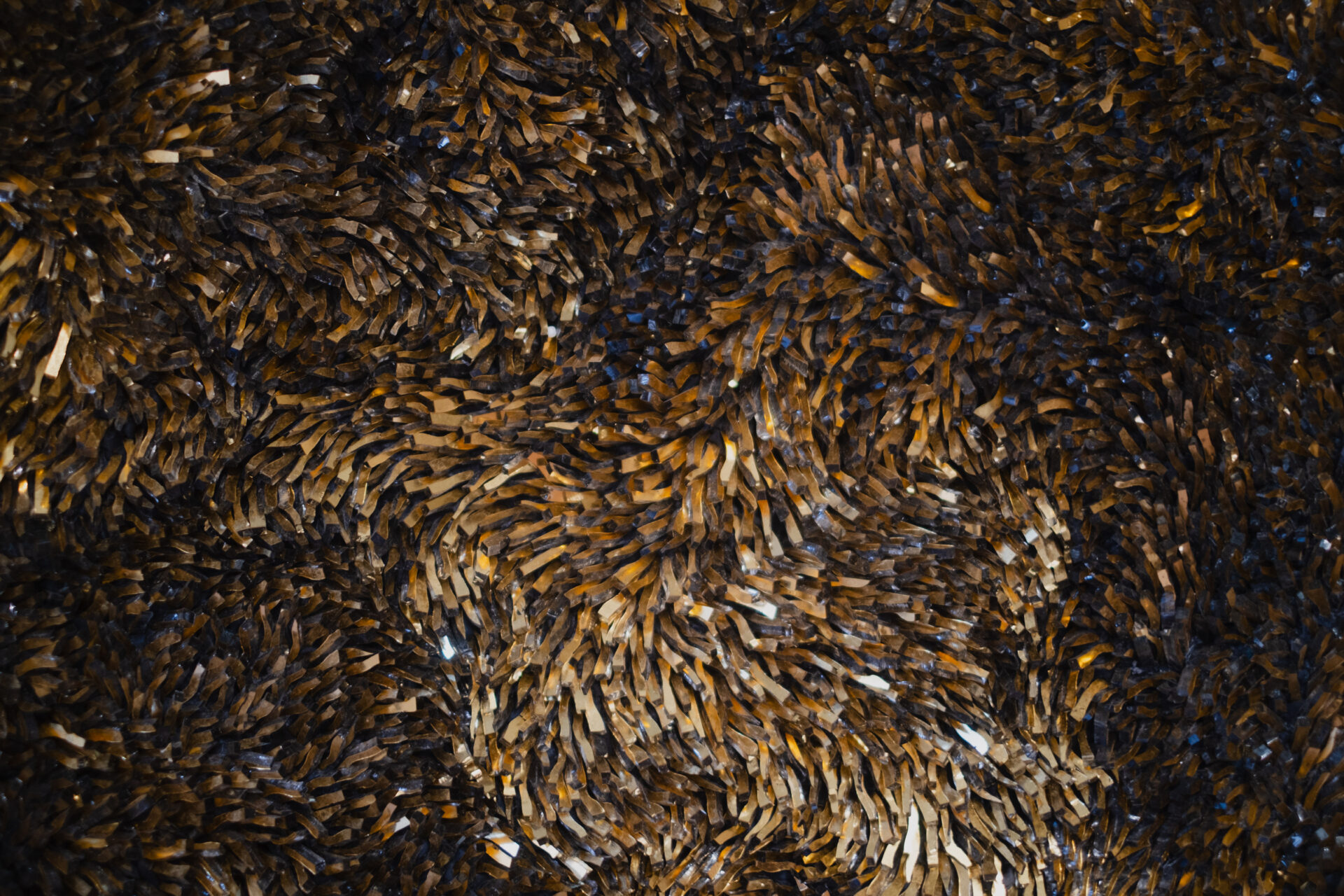
CaCO3's very "alive" mosaic

Artistic trio CaCO3, composed of Âniko Ferreira da Silva, Giuseppe Donnaloia, and Pavlos Mavromatidis
Now, back to Montalbini’s pavimento at Porta Adriana. The artist is being asked the big philosophical questions, the ones that waited for the first dozen bicycles to cycle over his work. How does he feel about the fact that the “lifespan” of his mosaic will exceed his own human years and likely inscribe his name in Ravenna’s history books?
“It’s terrifying!” he says. “It’s like I put an alien egg in the ground, and now I have to step back from it. I have to detach from it. But, like the ancient Roman mosaics that were unsigned, you can see that I haven’t put my name anywhere on this work,” he muses. “It’s a public work, and it’s my gift to the city. Yes, it will outlive me, and probably generations to come.”
